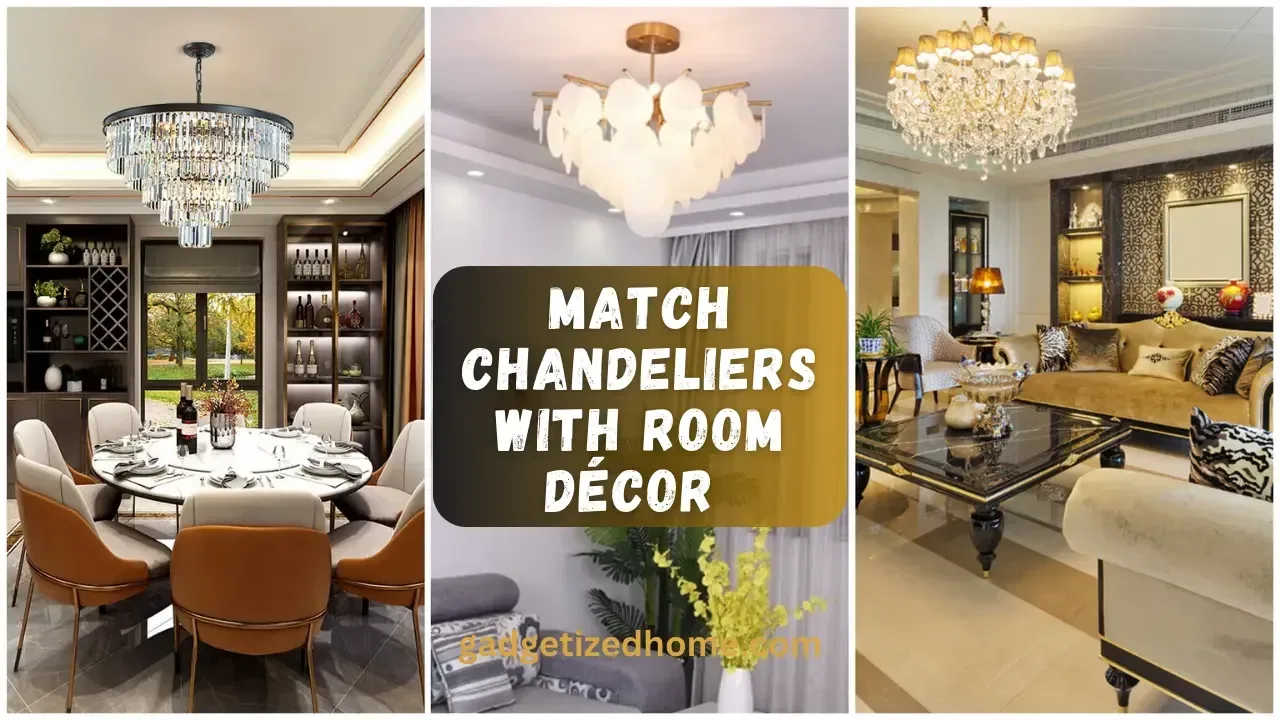Choosing the perfect chandelier isn’t just about picking a light fixture; it’s about selecting a piece that complements your room’s décor and furniture to create a harmonious, stylish environment.
A well-matched chandelier can serve as the centerpiece of a space, enhancing its overall design and ambiance. Whether you’re going for a modern, farmhouse, or traditional look, the right chandelier can bring everything together.
In this guide, we’ll walk you through how to match chandeliers with your room’s décor and furniture, helping you elevate your interior style effortlessly.
Understanding Your Room’s Style
Before selecting a chandelier, it’s essential to identify your room’s overall design style to ensure that the fixture complements the existing décor.
Identifying Room Style
Every room has its own personality, and understanding this helps guide your chandelier choice. Common room styles include:
- Modern: Clean lines, minimal décor, and neutral colors. Sleek, geometric chandeliers work well in this style.
- Farmhouse: Warm, rustic elements like wood and metal finishes. Look for chandeliers with a vintage or distressed appearance.
- Industrial: Exposed brick, metal accents, and raw finishes. Bold, metal-based chandeliers or fixtures with Edison bulbs fit perfectly.
- Minimalist: Simplicity, with few decorative elements. Opt for chandeliers with simple designs and minimal ornamentation.
- Traditional: Rich textures, classic furnishings, and ornate detailing. Crystal chandeliers or traditional multi-arm designs complement this style.
- Eclectic: A mix of patterns, textures, and styles. Choose chandeliers with unique designs that blend multiple elements, allowing the fixture to stand out.
Chandelier Styles That Match Popular Room Décor
Once you’ve identified the room’s style, it’s time to select a chandelier that enhances it:
- Modern Rooms: Pair with sleek and contemporary Modern Crystal Chandeliers to maintain clean aesthetics.
- Farmhouse Décor: Rustic, warm options like Farmhouse Chandeliers with wood or distressed metal finishes add charm.
- Industrial Spaces: Go bold with metal-heavy Rectangular Chandeliers or fixtures that showcase raw, unfinished elements.
- Minimalist Rooms: Choose simple, understated designs such as Linear Chandeliers for a clean and uncluttered look.
By identifying your room’s style, you can ensure your chandelier enhances the décor, creating a cohesive and visually appealing space.
Matching Chandeliers with Furniture Styles
To create a harmonious and well-designed space, it’s important to ensure your chandelier complements the style, shape, and material of your furniture.
Chandelier Shapes and Furniture Design
The shape and form of your chandelier should align with the design of your furniture to create a cohesive look. Here’s how to match them:
- Rectangular Tables or Furniture: For rectangular dining tables or coffee tables, choose a Rectangular Chandelier to mirror the shape and create balance.
- Round Tables or Sofas: Round or circular chandeliers, such as Round Crystal Chandeliers, work best with round furniture to maintain a smooth, continuous flow.
- Statement Furniture: If your furniture is the focal point of the room (e.g., a large sofa or statement dining set), choose a chandelier that complements it without overwhelming the space. For example, a sleek Modern Chandelier can subtly enhance bold furniture without stealing focus.
Chandelier Color and Material Coordination
The color and material of your chandelier should either blend with or contrast against your furniture to create a balanced visual effect.
- Matching Colors: If your room features neutral or muted tones, choose a chandelier that matches the furniture for a seamless look. For instance, a black chandelier pairs beautifully with black metal or dark wood furniture.
- Contrasting Finishes: If you want your chandelier to stand out, opt for contrasting finishes. For example, a gold or brass Modern Chandelier can add a pop of luxury against matte black furniture or a rustic wood dining table.
- Harmonizing Materials: Consider the materials used in your furniture. If your room includes wood furniture, chandeliers with wooden accents or rustic finishes work well. For metal or glass furniture, modern or industrial chandeliers with metal frames are ideal.
Matching your chandelier with the shapes, colors, and materials of your furniture ensures a cohesive and stylish interior, where all elements work together in perfect harmony.
Looking for stylish lighting on a budget? Check out our blog on the 8 Best Cheap Chandeliers under $100, where we feature affordable yet chic chandeliers that can transform your space without breaking the bank.
Considering the Size of the Chandelier in Relation to Room Size and Furniture
Choosing the right size chandelier is crucial for achieving a balanced and aesthetically pleasing look in your space. A chandelier that is too large or too small can disrupt the overall harmony of the room.
Size Guidelines
To ensure your chandelier fits perfectly within the room, consider the following guidelines:
- Basic Formula for Size: A common rule of thumb is to add the dimensions of the room in feet (length + width) and convert that number to inches to determine the ideal chandelier diameter. For example, a room that is 12 feet by 14 feet would suggest a chandelier that is about 26 inches in diameter (12 + 14 = 26).
- Chandelier Height: The height of the chandelier should also be considered. For dining areas, hang the chandelier about 30 to 36 inches above the table. In living rooms, aim for a height that allows for clear sight lines while still providing effective lighting.
Proportions
- Large Rooms: In spacious areas, larger chandeliers create a dramatic focal point and help fill the vertical space. Consider fixtures that are 30 inches or more in diameter to make a bold statement.
- Cozy Spaces: In smaller rooms, opt for more compact chandeliers to avoid overwhelming the space. Fixtures around 12 to 20 inches in diameter work well for intimate settings without feeling cramped.
- Visual Balance: Ensure that the size of the chandelier is proportionate to both the room and the surrounding furniture. For instance, a small chandelier might look lost over a large dining table, while an oversized chandelier can dominate a small breakfast nook.
By carefully considering the size of your chandelier in relation to the room and furniture dimensions, you can achieve a beautifully balanced and functional design that enhances your space.
Balancing Room Color Schemes with Chandeliers

The color and finish of your chandelier play a vital role in enhancing or contrasting with your room’s color scheme. By carefully selecting a chandelier that aligns with the room’s hues, you can create a cohesive and inviting atmosphere.
Chandelier Color and Lighting Temperature
- Blending Colors: If your room features a neutral or monochromatic color palette, choose a chandelier that matches or complements these tones. For example, a white or light-colored chandelier can seamlessly integrate into a soft pastel room, maintaining an airy feel.
- Contrasting Colors: For vibrant or bold color schemes, a chandelier with a contrasting finish can serve as an eye-catching focal point. A black or gold chandelier can stand out beautifully against colorful walls, adding elegance without overwhelming the décor.
Lighting Temperature and Room Ambiance
- Warm Lighting: Consider the color temperature of the light bulbs used in your chandelier. Warm, yellow tones create a cozy and inviting atmosphere, ideal for living rooms and bedrooms. Choose chandeliers that support warm bulbs, enhancing the room’s warmth and comfort.
- Cool Lighting: Cooler light tones work well in modern or minimalist spaces, providing a clean and refreshing ambiance. Opt for fixtures that allow for bright white or blue-toned bulbs to maintain a contemporary feel.
- Creating Mood: The right chandelier can also set the mood for the room. For example, a chandelier with dimmable features can adjust the ambiance according to the time of day or occasion, ensuring flexibility in lighting options.
By balancing your chandelier’s color and lighting temperature with the room’s overall color scheme, you can create a visually appealing space that feels both cohesive and inviting.
Coordinating Chandeliers with Other Lighting Fixtures
To create a well-lit and visually balanced space, it’s important to coordinate your chandelier with other lighting elements in the room. This layered approach enhances both functionality and aesthetics.
Layered Lighting Approach
- Understanding Layered Lighting: Layered lighting involves using different types of light sources to create depth and flexibility in a room’s illumination. This can include ambient, task, and accent lighting, all of which contribute to a well-rounded lighting design.
- Choosing Complementary Fixtures: When selecting additional lighting, aim for fixtures that complement the chandelier in style and finish. For instance, if you have a modern chandelier, consider sleek table lamps or wall sconces with similar geometric designs to maintain a cohesive look.
Lighting Zones
- Creating Defined Areas: Use chandeliers and other fixtures to define specific zones within an open-concept space. For example, a large chandelier can serve as the main source of light over a dining area, while wall sconces or floor lamps illuminate adjacent living areas.
- Balancing Function and Style: Ensure that each lighting source serves a functional purpose while contributing to the overall design. Task lighting, such as pendant lights over kitchen islands or desk lamps in reading areas, should work harmoniously with the chandelier to enhance usability without compromising style.
- Avoiding Over-Illumination: Be mindful of the overall brightness in the room. Too many bright fixtures can create an overwhelming effect. Instead, opt for a mix of lighting sources that provide adequate illumination without excessive glare.
By effectively coordinating your chandelier with other lighting fixtures, you can achieve a layered and balanced lighting scheme that enhances both the functionality and beauty of your space.
Budget Considerations
When selecting a chandelier, it’s essential to balance style and affordability to fit your budget.
Consider the initial purchase price along with potential upgrades, such as dimmers or energy-efficient bulbs, which can enhance functionality without requiring a complete fixture replacement.
Explore a range of options, including stylish yet budget-friendly chandeliers, to ensure you find a piece that complements your décor without breaking the bank. By doing so, you can achieve a stunning look while staying within your financial means.
The MEIXISUE Gold Modern Cheap Chandelier is the best affordable option with Stylish Elegance in our point of view.
Common Mistakes to Avoid
Choosing the right chandelier can be challenging, and avoiding common pitfalls can ensure a successful selection that enhances your space.
- Ignoring Scale: Selecting a chandelier that is too large or small for the room can disrupt the visual balance.
- Mismatched Styles: Choosing a chandelier that doesn’t align with the room’s overall design style can create a disjointed look.
- Overlooking Lighting Needs: Failing to consider the type and intensity of light required for the space can lead to inadequate illumination.
- Neglecting Height: Hanging a chandelier too high or too low can affect its functionality and aesthetic appeal.
- Disregarding Coordination: Not coordinating the chandelier with other lighting fixtures can result in an inconsistent lighting scheme.
By being mindful of these common mistakes, you can make a more informed choice that enhances your room’s overall design and functionality.
Dive into the world of lighting with our blog on 12 Types of Chandeliers: A Comprehensive Guide. This comprehensive resource explores various chandelier styles, helping you choose the perfect fixture to enhance your home’s ambiance and design.
Conclusion
Selecting the perfect chandelier involves thoughtful consideration of your room’s style, furniture, size, color scheme, and coordination with other lighting fixtures.
By keeping these factors in mind, you can create a cohesive and inviting atmosphere that enhances your space beautifully. Remember, the right chandelier not only serves as a functional light source but also as a stunning focal point that reflects your personal style.
Thank you for exploring these tips with us at Gadgetized Home—we hope you find the perfect chandelier to illuminate your home!
FAQs
Should the chandelier be centered with the room or table?
Chandeliers should generally be centered over a table, especially in dining rooms or kitchens, to ensure balance and proper lighting for the area. If there’s no central table, it’s best to align the chandelier with the focal point of the room, such as a seating area or a significant feature like a fireplace.
Should your chandeliers match?
Chandeliers don’t necessarily have to match, but they should complement each other and the overall room décor. If you’re using multiple chandeliers in the same room or adjacent spaces, they should share common design elements like finish, style, or color to maintain a cohesive look.
How do I choose a chandelier for my room?
When choosing a chandelier, consider the room’s style, size, and function. Measure the space to determine the appropriate chandelier size, and select a design that complements the décor. Also, think about the lighting needs—whether you need bright task lighting or soft ambient light—and ensure the fixture suits those requirements.
Do all the light fixtures have to match?
No, light fixtures don’t have to match exactly, but they should coordinate in style, finish, or color to create a harmonious look. Mixing different types of fixtures is perfectly fine as long as they contribute to a consistent design theme throughout the space.
Recent Posts
- 10 Best Nesting Tables for Small Spaces and Apartments
- 10 Best Ladder Bookshelves for Stylish Home Organization
- 9 Best Storage Trunks for Home Organization and Style
- 10 Best Room Dividers for Privacy and Stylish Spaces
- 11 Best Bar Carts for Entertaining Guests in Style
- 10 Best Decorative Accent Cabinets for Stylish Home Storage
- 9 Best Convertible Futons and Sofa Beds for Small Apartments
- 10 Best Modular Furniture Sets for Flexible and Functional Living
- 10 Best Cube Storage Units for Organized and Stylish Homes
- 9 Best Closet Organizer Systems for Maximizing Your Space
- 10 Best Murphy Beds and Wall Beds for Small Guest Rooms
- 15 Best Folding Furniture Pieces for Small Apartments and Studios
- 12 Best Storage Ottomans for Small Spaces and Apartment Living
- 9 Best Activity Tables for Kids for Fun and Learning
- 9 Best Kids’ Dressers for Organized Bedrooms
Our Main Categories
Ceiling Lights
- Chandeliers
- Wheel Chandeliers
- Pendant Lights
- Flush Mount Lights
- Track Lights
- Recessed Lights
- Semi Flush Mount Lights
- Cove Lights
Ceiling Fans with Lights
- Indoor Ceiling Fans
- Outdoor Ceiling Fans
- Ceiling Fans Light Kits
- Ceiling Fans Accessories
Wall Lighting
- Flush Mount Wall Lighting
- Wall Sconces
- Night Lighting
- Picture Lights
- Swing Arm Lights
- Step Lights
- Hall Lights
- Swing Arm Lamps
Outdoor Lighting
- Outdoor Wall Lights
- Outdoor Ceiling Lights
- Landscape Lighting
- String Lights
- Post Lights
- Motion Sensor Lights
- Dusk to Dawn Lights
- Lanterns
- Garden Lights
- Barn Lights
Lamps and Lamp Shades
- Table Lamps
- Floor Lamps
- Lamp Sets
- Desk Lamps
- Reading Lights
- Book lights
- LED Lamps
- Lamp Shades
Kitchen Lights
- Kitchen Island Lights
- Under Cabinet Lights
- Over Sink Lighting
- Under Cabinet Strip Lights
- Inside Cabinet Lights
Bathroom Lighting
- Bathroom Vanity Lights
- Bathroom Sconces
Special Lights
- Smart Bulbs
- Energy Efficient Lights
- Christmas Lights
- Festive String Lights
- Solar Lights
















